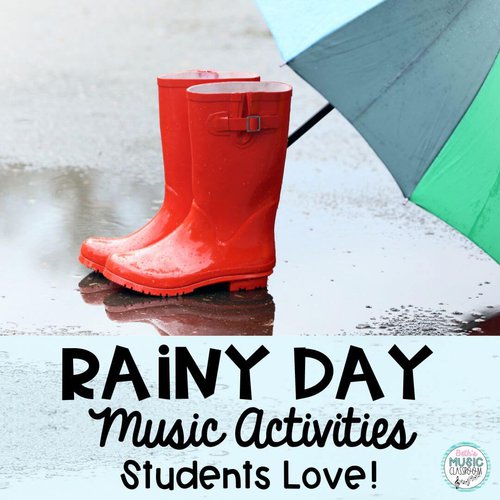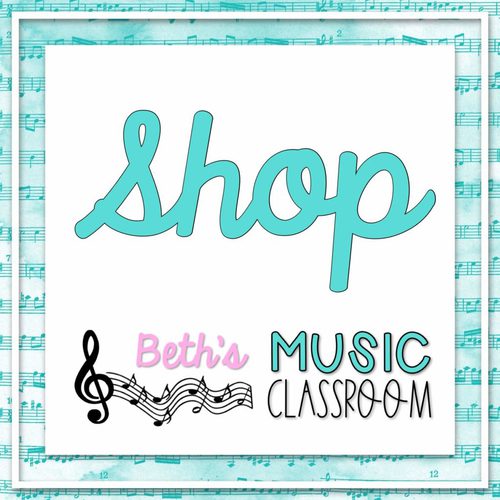
Easter is just around the corner, and it’s the perfect time to add some new ideas into your elementary music lessons. I love adding extra excitement to Easter music activities. I want to get students excited about learning and engaged during the lesson (during a very low-focus time of year). Today, I’m sharing with you some of my favorite Easter music lessons with easy-to-implement ideas for sparking excitement and enthusiasm in Kindergarten through 4th grade.
Movement and Action Songs
First, let’s start with movement. This time of the year, getting kids up and moving is so important and a big hit with elementary students. These activities require little to no prep other than securing a recording or video.
“The Bunny Hop” is a well-known song. I start by teaching students the simple rhythms of this dance. Then you can choose what works best for you and your students—getting up and hopping to the rhythms or playing them on instruments. Younger students will enjoy hopping along like bunnies, but just in case you have a student who cannot join in hopping, you have an alternative activity.
Another adorable Easter activity is with “Ballet of the Unhatched Chicks” by Mussorgsky. I use text to match the music, and have students move like they are an unhatched chick. They love it! Find out more by visiting this post. Also, add this body percussion play along for a quick brain break.
For my spring and Easter music lessons, I love using bunny songs. Here’s a few that add some movement and lyric improvisation for young children. Use the folk song “Old Mister Rabbit” or “John the Rabbit” to add motions and create new ways to move. For example, change the lyrics from “hop” to “skip” and from “cabbage” to a new vegetable.
You can also change the lyrics of “Hop Old Squirrel” to a bunny or a rabbit for a great Easter movement activity.
Instrumental Play-Alongs
Next, let’s look at ways to add instruments to your Easter music activities. Students can have fun while reviewing rhythmic reading. Add in some Easter rhythm play along games. Each Easter, I use these interactive games with each of my classes. A student chooses and clicks on any Easter picture, and it reveals the rhythm for that one. Everyone speaks, claps, or plays it, and then another student clicks on a new picture. Want to try it with your students? Click here!
With 2nd to 4th graders, I love adding Orff instruments to an Easter song. I rewrote the lyrics to “Hot Cross Buns” to create a simple melody for an exciting Orff arrangement. I use this every year with my students, and it helps reinforce solfege reading for mi-re-do.
But with younger students in preK to 1st grade, I have students perform rhythms and text and try piecing them together as a story. After some practice, I have them layer them on top of each other, and eventually, I add some festive Easter instrumental music—like “Here Comes Peter Rabbit.” This encourages them to focus on their rhythmic part, preparing rhythmic independence. You can do this with rhythm flashcards assigned to each instrument part, or you can also check out what I use here.
Easter Egg Games
Finally, let’s look at some fun Easter egg games. Especially before spring break, kids are in desperate need of some good old-fashioned play. That’s why I love using some passing and hiding games. There’s many different ones you can try, but here’s what I use with my students.
Hiding Games
Each year, I have a mini Easter egg hunt for my kindergarteners. I use a song from Music K8 called “Hunting Easter Eggs.” Depending on class size, divide your class into 2-3 groups to go hunting for plastic Easter eggs or egg shakers hidden around the room. Then when all students have found their egg shaker, we play a quick body percussion or rhythm play along video—mainly, so I can quickly hide all of the eggs again for the next group.
Passing Games
Another fun idea is to play a circle passing game with one student in the center closing their eyes. You can use the simple so-mi-la melody of “Who Has the Pumpkin,” but change the lyrics to “Easter egg.”
Let’s hide the Easter egg, let’s hide the Easter egg.
Who has the Easter egg, who has the Easter egg?
I have the Easter egg, I have the Easter egg.
Here’s a great video that adds singing, instruments, and a passing game:
I hope these Easter music activities bring some excitement and fresh, fun energy to your classroom this spring. These songs and ideas are easy to adapt for different grade levels and learning styles, giving you less to plan. Plus, they’re active and entertaining for young students, giving them a little movement and brain break. Try them out and see how your students respond!


Here’s some other posts you may like.




